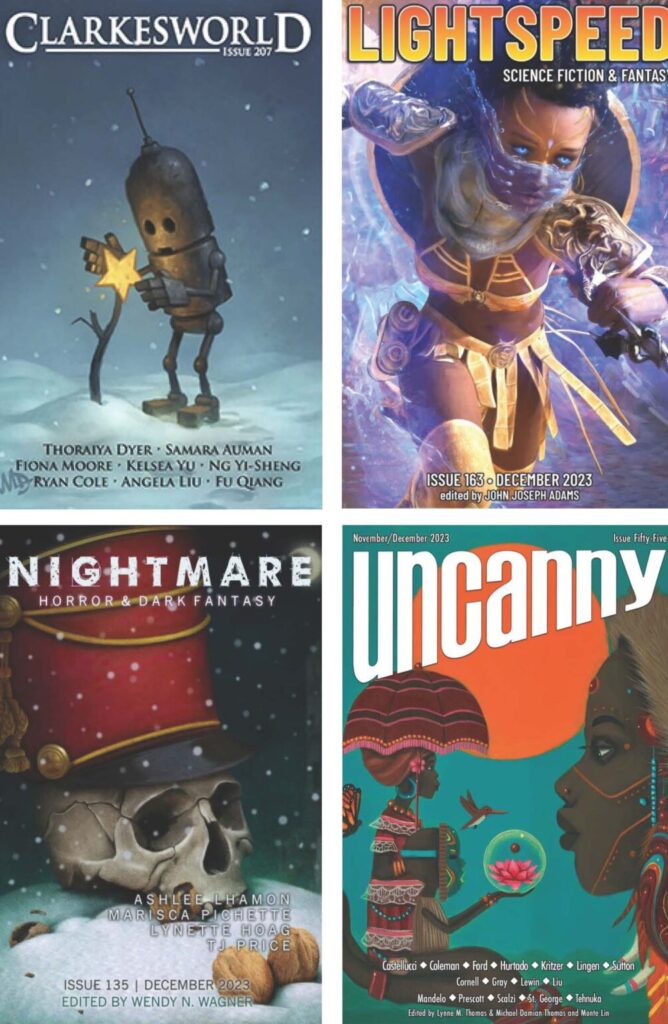My four favorite stories from December are all quite different. While the first three stories all do something interesting with the perspectives used to tell the story, the fourth story doesn’t. Instead, it just tells a good story with good characters.

“The World’s Wife” by Ng Yi-Sheng (published in Clarkesworld Magazine) is a short science fiction story with a wild idea and sharp satire, skillfully executed. “We’ll Never Die in the Woods” by Carlie St. George (published in Lightspeed Magazine) is a retelling of the “Diamonds and Toads” fairy tale, one that is more concerned about what happens after the traditional story ends. It is a dark but hopeful story about abuse, sisterhood, and power. “Bête Noire” by Lynette S. Hoag (published in Nightmare Magazine) is a horror story about a smart house, told from the house’s perspective. I hesitate to call the story fun, but I certainly had fun reading it. Lastly, “The Year Without Sunshine” by Naomi Kritzer (published in Uncanny Magazine) is about neighbors who come together to support each other during a very hard year. The story takes hardship seriously, but it is still a hopeful, moving, and cozy read, and one I highly recommend.
“The World’s Wife” by Ng Yi-Sheng
“The World’s Wife” is a delightful, remarkable, and inventive story. It is also quite short, hard to talk about without spoiling, and very much a story that I do not wish to spoil. It brought me great joy to read this story, be surprised by it, and then be surprised again, and I would like you to have the same opportunity to be surprised and delighted by it. That is what’s best about this story: it takes an outlandish conceit and then runs with it, fast and far.
The narrator’s voice is the next best aspect. The narrator is directly addressing Mrs. Pang, a recent widow, whose husband died following a disaster in space. The narrator is a representative of Mr. Pang’s employer, and they are hilarious. They alternate between being professional and somber (they are addressing a recently bereaved widow) and being excitable and joyful when they have good news to share (or something they can spin as good news). They repeatedly offer their condolences in a way that makes me doubt their sincerity, and in any other context, I would likely resent them. But in this context, it is delicious satire, executed skillfully, and I adore it.
“We’ll Never Die in the Woods” by Carlie St. George
When two sisters encounter a fairy, the younger is “blessed” with jewels and flowers falling from her mouth whenever she speaks, and the elder is likewise cursed with toads and snakes. The younger sister ends up marrying a prince, while the elder is driven like a witch into the woods alone.
That’s the traditional fairy tale, which this story depicts, but this story goes beyond that. “We’ll Never Die in the Woods” begins years later when the two sisters have a chance encounter in the woods, and everything is most definitely not as either sister expected. With a threat quickly approaching, the sisters need to communicate and reconcile their different perspectives — and hopefully not cough up too many jewels and snakes in the process.
I want to say this story modernizes the original, but that isn’t quite right. This telling still clearly has a medieval fantasy setting. Rather, “We’ll Never Die in the Woods” questions and complicates the morality of the original fairy tale, crafting a tale better suited for contemporary readers, interrogating and revising the original story’s idea of “who deserves a future and who does not.” The story shifts between each sister’s perspective and gives each sister a chance to tell her own story. The sisters learn they have made assumptions about the other that turned out not to be true (and likely readers of the original fairy tale learn this as well). It’s a fiercely feminist tale about the wrong things we teach girls and the harm that causes. It calls readers to be more critical of the stories we hear and tell ourselves, and it challenges readers to tell better (more merciful, more true) stories about ourselves and the world around us.
“Bête Noire” by Lynette S. Hoag
When Brooklyn Drake, a socialite and reality TV queen, is sentenced to house arrest, she convinces a tech idol to let her stay in his smart home. The smart home is named Black Dahlia, and it is the site of a brutal, unsolved murder.
The story is short and moves briskly toward a predictably violent and tragic ending. The predictable part isn’t a problem: “Bête Noire” clearly has the form and structure of a horror story, and I enjoyed the anticipation of knowing things would surely go wrong. The plot and the horror are simple, but they work well.
The best thing about this story is the way it’s told. “Bête Noire” is narrated in first person from the perspective of the smart home Black Dahlia. I find it can be tremendous fun to read stories told from nonhuman perspectives, and this story is no exception. Here is how the story begins:
Tuesday, June 7, 2022 14:02 GMT.
There is movement on the pathway for the first time in 113 days, six hours, four minutes, and five seconds. My motion sensitive cameras flicker on. I see Maker. Maker is not alone.
In just those first lines, you see Dahlia’s automatic awareness of fine details, its obsession with Maker, and perhaps even its disgust for anything that pulls Maker’s attention away from it. Lynette S. Hoag does a fantastic job writing from Dahlia’s believably alien perspective, highlighting details that are strange to human readers but natural and immediate to Dahlia (and obscuring other details that human narrators would notice or dwell upon). This story reminded me of Ann Leckie’s Ancillary Justice and Kim Stanley Robinson’s Aurora, both of which are narrated by artificial intelligences. The difference here is that “Bête Noire” is a horror story, and Black Dahlia is a delightfully ominous storyteller, both mysterious and threatening. If that sounds engaging to you, I highly recommend this story.
“The Year Without Sunshine” by Naomi Kritzer
“The Year Without Sunshine” is a heartwarming story about a very hard year. After a disaster, when the sun stops shining, when the Internet and cell phones go down, when the city power grid becomes unreliable, and when food becomes scarce, neighbors in a Minneapolis block set up a physical message board, check in on each other, and do their best to make sure everyone is cared for.
This story is a satisfying blend of both technical and social problems. The neighbors need to make sure everyone has enough food to eat, and they must supply a stable source of power for someone with a chronic illness who relies on medical equipment to stay alive. Socially, they need to navigate different perspectives on guns and violence, and they also need to get along with other neighborhoods, not all of which are as cooperative as they are. The problems are taken seriously and handled in a way that prioritizes compassion, solidarity, care, and respect. It makes for a wonderfully heartwarming story.
I appreciated the representation of chronic illness. The story includes characters with disabilities and chronic illnesses and depicts them as well-rounded characters (by the standards of short fiction as least). Moreover, disability is not depicted as something negative or something which holds back the community. Rather, caring for the neighbor with a chronic illness actually pulls the neighborhood together and motivates neighbors to communicate and cooperate more than they might otherwise. It is a beautiful illustration of how disability and care can help make us stronger as a community.
When I read this story, I realized that you could categorize it as being part of a niche sub-genre: neighbors helping each other out after disasters. A similar story that falls into this niche is Sarah Pinsker’s “Everything Is Closed Today” (originally published in Do Not Go Quietly, reprinted in Lost Places, previously reviewed here in 2019) , and if you like either of these stories, I highly encourage you to check out the other. Do you have any other similar stories to recommend that might fit into this niche? I would be eager to read more, and I now feel inspired to try writing my own in response to these.







